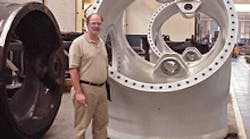Authored by: Resources: |
The U.S. wind-turbine industry has suffered because government funds aimed at renewable energy have often gone towards buying foreign-made parts. At least, that is the common belief among the general public and, it would seem, the wind industry itself. For example, a recent article in a publication from the American Wind Energy Association stated that the U. S. has ceded its leading position for large sand-casted components for nacelles to the Taiwanese.
This statement misrepresents the current situation, says Rahul Gangulee, director of supply-chain management at Winergy Drive Systems Corp., Elgin, Ill. “The sheer logistics of handling the massive components is driving European OEMs away from Asian suppliers and towards U. S. producers,” says Gangulee. “Buying large castings from China meant long lead times, slow supplier responses, and high freight and handling fees. And the next generations of wind turbines tend to be even larger, which further bolsters the use of U. S. suppliers.”
Currently, facilities such as Hodge Foundry in Greenville, Pa., and Elyria Foundry in Elyria, Ohio, manufacture nacelle components and other massive, utility-scale wind-turbine castings weighing more than 48,000 lb each.
Boding well for future development, USA LLC, part of Finland’s URV Foundry, was recently awarded a $3.5 million grant and a $500,000 loan from the federal government to build a foundry in Eaton Rapids, Mich. It will make castings for wind-turbine components. The foundry will be next to one of its customers, wind-turbine manufacturer Astraeus Wind Energy Inc. “URV castings are best in class,” says Jeff Metts, president of Astraeus. “They will let our company compete with China and any other country.”
Additionally, the American Foundry Society (AFS) and Hodge Foundry recently met with the DoE Wind Sector Energy Leader and specialist from Sandia Labs to discuss boosting the U. S. supply base for wind-energy castings. AFS has also held several sessions on wind energy at its recent Casting Congresses that included participants from U. S. foundries and wind-energy companies. Discussions centered around how to keep OEMs informed about domestic sourcing and that U. S. manufacturers must meet global casting standards.
The idea that American casting technology somehow couldn’t handle wind-turbine needs may have arisen because wind technology was pioneered in Europe using ductile-iron castings, says Raymond W. Monroe, executive vice president of the Steel Founders’ Society of America. “Engineers there designed large castings such as the hub, frame, and gearboxes,” he says. “Europe was the world leader in capacity, with components coming mainly from Germany and Spain.”
The quest to further slash costs eventually drove many European firms to use Asian sources, mainly Chinese, says Monroe. “Money for wind ended up buying castings from Asia because of lower costs from undervalued currencies, cheap labor, and unfair trade policies. But as components get larger, outsourcing to Asia is no longer as attractive.”
About the Author
Leslie Gordon
Leslie serves as Senior Editor - 5 years of service. M.S. Information Architecture and Knowledge Management, Kent State University. BA English, Cleveland State University.
Work Experience: Automation Operator, TRW Inc.; Associate Editor, American Machinist. Primary editor for CAD/CAM technology.
